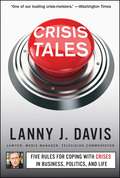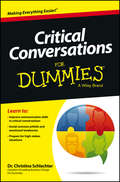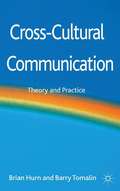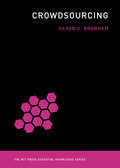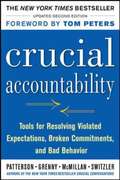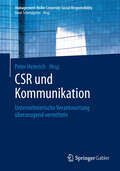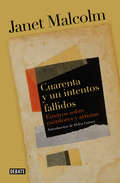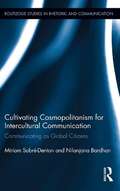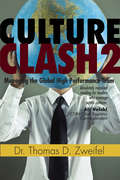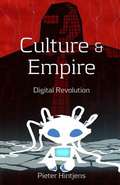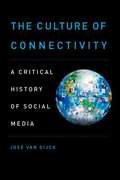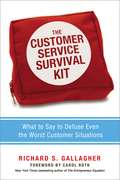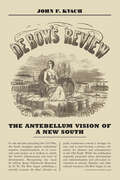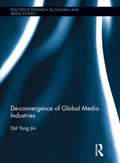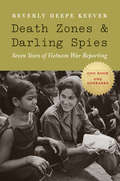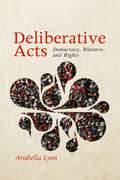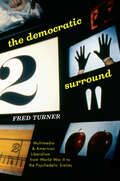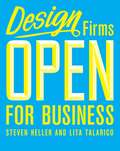- Table View
- List View
Crisis Tales: Five Rules for Coping with Crises in Business, Politics, and Life
by Lanny J. DavisTELL IT ALL, TELL IT EARLY, TELL IT YOURSELF Nobody ever calls Lanny Davis to give him good news. As a legal crisis manager, he's the man public figures such as Bill Clinton, Martha Stewart, U.S. representative Charlie Rangel, and companies such as Whole Foods, among many others, rely on to pull them through public scandal with their reputations intact. Winning your case in a courtroom instead of the media is no longer a viable option. These days, every scandal is tried in the court of public opinion. Refusing to dignify allegations with an answer is grounds for flagellation by the press. Political insider Davis has spent years helping politicians, sports figures, business executives, and corporations through the biggest reputation crises of our times, and each case has aided him in the creation of five invaluable rules that absolutely anyone can use to protect himself from damaging hearsay-- online and off. In this fascinating and practical resource, Davis tells the real stories behind his famous clients' very public scandals as he explains what he and his team did right, what they did wrong, and how they learned from their mistakes and successes. As impossible as it is to believe, many public relations experts still rely on the faulty Nixon model--deny, deny, deny. This tactic was detrimental not only to Nixon's presidency but, for example, to Exxon and BP (not Davis's clients) following major oil spills. Instead, Davis believes, it is important to tell the full story yourself, even if it means sharing unflattering details before they leak on their own. By getting ahead of the story, you have more control over how the information is reported and perceived in the media. Damaging falsehoods can go viral in an instant, but the nation's premier political spin doctor will teach you how to fight back.
Crisis Tales
by Lanny J. DavisTELL IT ALL, TELL IT EARLY, TELL IT YOURSELF Nobody ever calls Lanny Davis to give him good news. As a legal crisis manager, he's the man public figures such as Bill Clinton, Martha Stewart, U.S. representative Charlie Rangel, and companies such as Whole Foods, among many others, rely on to pull them through public scandal with their reputations intact. Winning your case in a courtroom instead of the media is no longer a viable option. These days, every scandal is tried in the court of public opinion. Refusing to dignify allegations with an answer is grounds for flagellation by the press. Political insider Davis has spent years helping politicians, sports figures, business executives, and corporations through the biggest reputation crises of our times, and each case has aided him in the creation of five invaluable rules that absolutely anyone can use to protect himself from damaging hearsay-- online and off. In this fascinating and practical resource, Davis tells the real stories behind his famous clients' very public scandals as he explains what he and his team did right, what they did wrong, and how they learned from their mistakes and successes. As impossible as it is to believe, many public relations experts still rely on the faulty Nixon model--deny, deny, deny. This tactic was detrimental not only to Nixon's presidency but, for example, to Exxon and BP (not Davis's clients) following major oil spills. Instead, Davis believes, it is important to tell the full story yourself, even if it means sharing unflattering details before they leak on their own. By getting ahead of the story, you have more control over how the information is reported and perceived in the media. Damaging falsehoods can go viral in an instant, but the nation's premier political spin doctor will teach you how to fight back.
Critical Conversations For Dummies
by Christina Tangora SchlachterThe easy way to communicate best when it matters mostMost people are aware of the importance of handling critical conversations well. However, when it comes down to actually being in a difficult situation that calls for key communication skills, many do not know how to practically apply their own thoughts.Critical Conversations For Dummies is a step-by-step reference for the variety of crucial conversations life presents in the workforce. It's packed with strategies for preparing for high-stakes situations; being persuasive (not abrasive); knowing the value of assertive communication; resolving failed promises and missed deadlines; maintaining morale when firing staff; getting new employees off on the right foot; managing staff relations and strengthening team relationships; understanding audience needs and motivations to get positive results; altering confrontational language to cooperative language during difficult conversations; and building relationships in the face of conflict.Improve communication skills in crucial conversationsAvoid common pitfalls and emotional tendenciesDiscover the benefits of success in crucial conversations This book is especially relevant to the hundreds of thousands of leaders who are tasked with multiple duties, whether addressing complex problems from stakeholders or achieving exceptional results from staff.
Cross-Cultural Communication
by Brian J. Hurn Barry TomalinA comprehensive survey of the key areas of research in cross-cultural communication, based on the authors' experience in organizing and delivering courses for undergraduate and postgraduate students and in business training in the UK and overseas.
Crowdsourcing (The MIT Press Essential Knowledge series)
by Daren C. BrabhamA concise introduction to crowdsourcing that goes beyond social media buzzwords to explain what crowdsourcing really is and how it works.Ever since the term “crowdsourcing” was coined in 2006 by Wired writer Jeff Howe, group activities ranging from the creation of the Oxford English Dictionary to the choosing of new colors for M&Ms have been labeled with this most buzz-generating of media buzzwords. In this accessible but authoritative account, grounded in the empirical literature, Daren Brabham explains what crowdsourcing is, what it is not, and how it works.Crowdsourcing, Brabham tells us, is an online, distributed problem solving and production model that leverages the collective intelligence of online communities for specific purposes set forth by a crowdsourcing organization—corporate, government, or volunteer. Uniquely, it combines a bottom-up, open, creative process with top-down organizational goals. Crowdsourcing is not open source production, which lacks the top-down component; it is not a market research survey that offers participants a short list of choices; and it is qualitatively different from predigital open innovation and collaborative production processes, which lacked the speed, reach, rich capability, and lowered barriers to entry enabled by the Internet.Brabham describes the intellectual roots of the idea of crowdsourcing in such concepts as collective intelligence, the wisdom of crowds, and distributed computing. He surveys the major issues in crowdsourcing, including crowd motivation, the misconception of the amateur participant, crowdfunding, and the danger of “crowdsploitation” of volunteer labor, citing real-world examples from Threadless, InnoCentive, and other organizations. And he considers the future of crowdsourcing in both theory and practice, describing its possible roles in journalism, governance, national security, and science and health.
Crucial Accountability: Tools for Resolving Violated Expectations, Broken Commitments, and Bad Behavior (Second Edition)
by Kerry Patterson Joseph Grenny Ron Mcmillan Al Switzler David Maxfield.In this UPDATED SECOND EDITION (first edition titled "Crucial Confrontations"), you'll learn how to hold anyone accountable, master performance discussions, and get results. Everyone knows how to run for cover, or, if sufficiently provoked, step up to problems in a way that causes a real ruckus. Crucial Accountability teaches you how to deal with violated expectations in a way that solves the problem at hand without harming the relationship--and, in fact, even strengthens it. Broken promises, missed deadlines, poor behavior--they don't just make others' lives miserable; they can sap up to 50 percent of organizational performance and account for the vast majority of divorces. Crucial Accountability offers the tools for improving relationships in the workplace and in life and for resolving all these problems--permanently.
CSR und Kommunikation: Unternehmerische Verantwortung überzeugend vermitteln (Management-Reihe Corporate Social Responsibility)
by Peter HeinrichCorporate Social Responsiblity gewinnt zunehmend an Bedeutung. Viele Unternehmen engagieren sich heute gesellschaftlich und übernehmen Verantwortung. Ein sinnvoller Schritt, denn so leisten sie einen Beitrag zur gesamtwirtschaftlichen Nachhaltigkeit, prägen ihr Image und generieren dabei gezielt Wettbewerbsvorteile. Ein wichtiger Schlüssel zum Erfolg liegt dabei in der Kommunikation. Sie muss fundiert, professionell gesteuert und langfristig angelegt sein, um die Engagements intern zu kommunizieren und auch das öffentliche Bewusstsein für dieses Thema zu schärfen. ,,Tue Gutes und sprich darüber" - es geht um einen Dialog mit allen relevanten Stakeholdern. Dieses Buch liefert einen fundierten, praxisbezogenen Überblick über die Kommunikationsinstrumente und -möglichkeiten sowie den Planungsprozess. Es ist ein Ideenkatalog und vermittelt zugleich auch das wissenschaftliche Hintergrundwissen. Experten aus verschiedenen Branchen zeigen, wie die CSR-Kommunikation wirksam angewendet wird. Letztendlich soll es den Menschen, die sich mit CSR beschäftigen - ob auf Unternehmens- oder Beraterseite, ob als Newcomer oder Experte - Orientierung, Impulse und Handlungsempfehlungen für die tägliche Praxis geben.
CSR und Kommunikation: Unternehmerische Verantwortung Uberzeugend Vermitteln (Management-Reihe Corporate Social Responsibility)
by Peter HeinrichDiese aktualisierte und überarbeitete 2. Auflage liefert einen fundierten, praxisbezogenen Überblick über die Kommunikationsinstrumente und -möglichkeiten sowie den Planungsprozess im Bereich CSR. Es ist ein Ideenkatalog und vermittelt zugleich auch das wissenschaftliche Hintergrundwissen. 20 Praxisbeiträge aus verschiedenen Branchen zeigen, wie die CSR-Kommunikation wirksam angewendet wird. Viele Unternehmen engagieren sich heute gesellschaftlich und übernehmen Verantwortung. Ein sinnvoller Schritt, denn so leisten sie einen Beitrag zur gesamtwirtschaftlichen Nachhaltigkeit, prägen ihr Image und generieren dabei gezielt Wettbewerbsvorteile. Ein wichtiger Schlüssel zum Erfolg liegt dabei in der Kommunikation. „Tue Gutes und sprich darüber“ – es geht um die Kommunikation mit allen relevanten Dialoggruppen. In diesem Zusammenhang gibt dieses Buch den Menschen, die sich mit CSR beschäftigen – ob auf Unternehmens- oder Beraterseite, ob als Newcomer oder als Experte – Orientierung, Impulse und Handlungsempfehlungen für die tägliche Praxis.
Cuarenta y un intentos fallidos: Ensayos sobre escritores y artistas
by Janet MalcolmLos mejores ensayos sobre arte y literatura de una maestra del periodismo Uno de los libros del 2013 para el Publisher Weekly y finalista del premio de la crítica de EEUU La obra de Janet Malcolm figura destacada en cualquier canon de la no ficción contemporánea, con piezas tan brillantes como la que da título a esta antología, con sus cuarenta y un intentos fallidos de comenzar un perfil del pintor David Salle, que acaban componiendo un retrato excepcional del artista. Malcolm está entre los autores más estimulantes intelectualmente, capaz de convertir «epifanías de la percepción en estallidos de conocimiento» como escribió David Lehman en The Boston Globe. Esta antología reúne piezas publicadas a lo largo de varias décadas, sobre todo en The New Yorker y The New York Review of Books, que recogen su interés por los artistas y su trabajo, pintores, fotógrafos, escritores y críticos. Explora la obsesión del grupo de Bloomsbury por la creación tanto plástica como literaria; las apasionadas colaboraciones que hay detrás de los desnudos de Edward Weston; y la personalidad del fotógrafo alemán Thomas Struth, que vive «bajo la sombra de su pasado nazi», pero cuyas fotografías muestran «ligereza de espíritu». Se asoma a la ficción de Edith Wharton y a los héroes puros de Salinger. «Una y otra vez», como escribió Ian Frazier, «demuestra que la no ficción, un libro reportaje, un artículo de revista, algo que vemos a diario, puede alcanzar el más alto nivel literario.» La crítica ha dicho... «Cuarenta y un intentos fallidos es una obra notable y a su extraña manera fascinante. Consigue algo muy difícil: explicar algo valioso sobre un tema tan inasible como es el proceso creativo.» Zoe Heller, The New York Review of Books «Una excelente colección de ensayos. Malcolm probablemente sea la escritora más dotada del periodismo americano.» Chicago Tribune «Periodismo inteligente que siempre se nota que ha sido escrito por un ser humano, con un corazón que late, un sentido moral, una curiosidad muy amplia y un punto de vista.» Laura Collins-Hughes, The Boston Globe «Sin duda la obra de un genio.» Adam Kitsch, New York Times
Cultivating Cosmopolitanism for Intercultural Communication: Communicating as a Global Citizen (Routledge Studies in Rhetoric and Communication #15)
by Miriam Sobre-Denton Nilanjana BardhanWinner of the National Communication Association's International and Intercultural Communication Division's 2014 Outstanding Authored Book of the Year award This book engages the notion of cosmopolitanism as it applies to intercultural communication, which itself is undergoing a turn in its focus from post-positivistic research towards critical/interpretive and postcolonial perspectives, particularly as globalization informs more of the current and future research in the area. It emphasizes the postcolonial perspective in order to raise critical consciousness about the complexities of intercultural communication in a globalizing world, situating cosmopolitanism—the notion of global citizenship—as a multilayered lens for research. Cosmopolitanism as a theoretical repertoire provides nuanced descriptions of what it means to be and communicate as a global citizen, how to critically study interconnectedness within and across cultures, and how to embrace differences without glossing over them. Moving intercultural communication studies towards the global in complex and nuanced ways, this book highlights crucial links between globalization, transnationalism, postcolonialism, cosmopolitanism, social injustice and intercultural communication, and will help in the creation of classroom spaces devoted to exploring these links. It also engages the links between theory and praxis in order to move towards intercultural communication pedagogy and research that simultaneously celebrates and interrogates issues of cultural difference with the aim of creating continuity rather than chasms. In sum, this book orients intercultural communication scholarship firmly towards the critical and postcolonial, while still allowing the incorporation of traditional intercultural communication concepts, thereby preparing students, scholars, educators and interculturalists to communicate ethically in a world that is simultaneously global and local.
The Cultural Dimension of Global Business 7th Edition
by Gary P. Ferraro Elizabeth K. BriodyThe Cultural Dimension of Global Business provides a foundation for understanding the impact of culture on global business and global business on culture.
Culture and Psychology (5th Edition)
by David Matsumoto Linda JuangThis book puts psychological theories and concepts into a cross-cultural framework that invites readers to discover, question, and ultimately, understand the relationship between culture and psychology through exploration of topics like changing gender roles, sexuality, self-esteem, aggression, personality, and mate selection.
Culture Clash 2: Managing the Global High Performance Team
by Thomas D. ZweifelFew are prepared for managing across cultures, and the costs of cultural blind spots can spin out of control-from lawsuits to lost opportunities. Forged in the fire of clashing cultures and living on four continents, Dr. Zweifel developed a fool-proof methodology for managing successfully across borders. And post-9/11, the Arab Spring and the BRICS emerging markets, e-commerce and social networks have made this updated and expanded edition of Culture Clash indispensible. Culture Clash 2 is not another Kiss, Bow or Shake Hands. Such protocol-laden works on whether to bring wine to a dinner in Singapore or how many times to kiss in France might have their uses, but non-compliance with local etiquette has rarely been a deal-breaker. What has derailed international business is the inability of managers to see the world from their counterpart's point of view, read between the lines, and decode the mind-set of the other side.
Culture & Empire: Digital Revolution
by Pieter HintjensThe whole planet is getting connected and building vast new communities. Our new communities are a very real challenge to old power and old money. And old money -- after its War on Drugs and War on Terror -- is now launching its War on the Internet. What is going on, and where will this lead us? Pieter Hintjens tells all in this vast story of Culture & Empire: Digital Revolution.
The Culture Of Connectivity: A Critical History Of Social Media
by Jose Van DijckSocial media has come to deeply penetrate our lives: Facebook, YouTube, Twitter and many other platforms define many of our daily habits of communication and creative production. The Culture of Connectivity studies the rise of social media in the first decade of the twenty-first century up until 2012, providing both a historical and a critical analysis of the emergence of major platforms in the context of a rapidly changing ecosystem of connective media. Such history is needed to understand how these media have come to profoundly affect our experience of online sociality. The first stage of their development shows a fundamental shift. While most sites started out as amateur-driven community platforms, half a decade later they have turned into large corporations that do not just facilitate user connectedness, but have become global information and data mining companies extracting and exploiting user connectivity. Author and media scholar Jose van Dijck offers an analytical prism to examine techno-cultural as well as socio-economic aspects of this transformation. She dissects five major platforms: Facebook, Twitter, Flickr, YouTube, and Wikipedia. Each of these microsystems occupies a distinct position in the larger ecology of connective media, and yet, their underlying mechanisms for coding interfaces, steering users, and filtering content rely on shared ideological principles. At the level of management and organization, we can also observe striking similarities between these platforms' shifting ownership status, governance strategies, and business models. Reconstructing the premises on which these platforms are built, this study highlights how norms for online interaction and communication gradually changed. "Sharing," "friending," "liking," "following," "trending," and "favoriting" have come to denote online practices imbued with specific technological and economic meanings. This process of normalization, the author argues, is part of a larger political and ideological battle over information control in an online world where everything is bound to become social. Crossing lines of technological, historical, sociological, and cultural inquiry, The Culture of Connectivity will reshape the way we think about interpersonal connection in the digital age.
The Customer Service Survival Kit: What to Say to Defuse Even the Worst Customer Situations
by Richard S. GallagherThe worst customer situations demand more of front-line employees than good intentions and the right attitude. These kinds of issues can send seasoned service professionals into red alert, and require the communication skills of a crisis counselor. The Customer Service Survival Kit explains how to use the right words toturn volatile scenarios into calm and productive customer encounters. Anyone can learn this delicate art with the book's blend of clear techniques, lessons from behavioral science, case studies, situation-specific advice, and practice exercises. Readers will discover: * The power of leaning into criticism * Trigger phrases that can make bad situations worse * The secret to helping people feel deeply heard in a crisis * How to use the divide-and-conquer approach to safely deliver bad news * Indispensable problem-solving tools * How to become immune to intimidation * How to wrap up transactions so that customers are happy * And more! Best yet, learning to handle worst-case scenarios has the spillover effect of boosting the skills and confidence needed to deal effectively with ANY customer - the key to radical improvements in every organization.
Cyber Security
by John G. VoellerCyber Security features articles from the Wiley Handbook of Science and Technology for Homeland Security covering topics related to cyber security metrics and measure and related technologies that meet security needs. Specific applications to web services, the banking and the finance sector, and industrial process control systems are discussed.
De Bow's Review: The Antebellum Vision of a New South (New Directions In Southern History Ser.)
by John F. KvachIn the decades preceding the Civil War, the South struggled against widespread negative characterizations of its economy and society as it worked to match the North's infrastructure and level of development. Recognizing the need for regional reform, James
De-Convergence of Global Media Industries: De-convergence Of Global Media Industries (Routledge Research in Cultural and Media Studies #47)
by Dal Yong JinConvergence has become a buzzword, referring on the one hand to the integration between computers, television, and mobile devices or between print, broadcast, and online media and on the other hand, the ownership of multiple content or distribution channels in media and communications. Yet while convergence among communications companies has been the major trend in the neoliberal era, the splintering of companies, de-convergence, is now gaining momentum in the communications market. As the first comprehensive attempt to analyze the wave of de-convergence of the global media system in the context of globalization, this book makes sense of those transitions by looking at global trends and how global media firms have changed and developed their business paradigm from convergence to de-convergence. Jin traces the complex relationship between media industries, culture, and globalization by exploring it in a transitional yet contextually grounded framework, employing a political economic analysis integrating empirical data analysis.
Death Zones and Darling Spies: Seven Years of Vietnam War Reporting (Studies in War, Society, and the Military)
by Beverly Deepe KeeverChosen for 2015 One Book One NebraskaIn 1961, equipped with a master&’s degree from famed Columbia Journalism School and letters of introduction to Associated Press bureau chiefs in Asia, twenty-six-year-old Beverly Deepe set off on a trip around the world. Allotting just two weeks to South Vietnam, she was still there seven years later, having then earned the distinction of being the longest-serving American correspondent covering the Vietnam War and garnering a Pulitzer Prize nomination.In Death Zones and Darling Spies, Beverly Deepe Keever describes what it was like for a farm girl from Nebraska to find herself halfway around the world, trying to make sense of one of the nation&’s bloodiest and bitterest wars. She arrived in Saigon as Vietnam&’s war entered a new phase and American helicopter units and provincial advisers were unpacking. She tells of traveling from her Saigon apartment to jungles where Wild West–styled forts first dotted Vietnam&’s borders and where, seven years later, they fell like dominoes from communist-led attacks. In 1965 she braved elephant grass with American combat units armed with unparalleled technology to observe their valor—and their inability to distinguish friendly farmers from hide-and-seek guerrillas.Keever&’s trove of tissue-thin memos to editors, along with published and unpublished dispatches for New York and London media, provide the reader with you-are-there descriptions of Buddhist demonstrations and turning-point coups as well as phony ones. Two Vietnamese interpreters, self-described as &“darling spies,&” helped her decode Vietnam&’s shadow world and subterranean war. These memoirs, at once personal and panoramic, chronicle the horrors of war and a rise and decline of American power and prestige.
Deliberative Acts: Democracy, Rhetoric, and Rights (Rhetoric and Democratic Deliberation #7)
by Arabella LyonThe twenty-first century is characterized by the global circulation of cultures, norms, representations, discourses, and human rights claims; the arising conflicts require innovative understandings of decision making. Deliberative Acts develops a new, cogent theory of performative deliberation. Rather than conceiving deliberation within the familiar frameworks of persuasion, identification, or procedural democracy, it privileges speech acts and bodily enactments that constitute deliberation itself, reorienting deliberative theory toward the initiating moment of recognition, a moment in which interlocutors are positioned in relationship to each other and so may begin to construct a new lifeworld. By approaching human rights not as norms or laws, but as deliberative acts, Lyon conceives rights as relationships among people and as ongoing political and historical projects developing communal norms through global and cross-cultural interactions.
Deliberative Acts: Democracy, Rhetoric, and Rights (Rhetoric and Democratic Deliberation)
by Arabella LyonThe twenty-first century is characterized by the global circulation of cultures, norms, representations, discourses, and human rights claims; the arising conflicts require innovative understandings of decision making. Deliberative Acts develops a new, cogent theory of performative deliberation. Rather than conceiving deliberation within the familiar frameworks of persuasion, identification, or procedural democracy, it privileges speech acts and bodily enactments that constitute deliberation itself, reorienting deliberative theory toward the initiating moment of recognition, a moment in which interlocutors are positioned in relationship to each other and so may begin to construct a new lifeworld. By approaching human rights not as norms or laws, but as deliberative acts, Lyon conceives rights as relationships among people and as ongoing political and historical projects developing communal norms through global and cross-cultural interactions.
Democracy and Media Decadence
by John KeaneWe live in a revolutionary age of communicative abundance in which many media innovations - from satellite broadcasting to smart glasses and electronic books - spawn great fascination mixed with excitement. In the field of politics, hopeful talk of digital democracy, cybercitizens and e-government has been flourishing. This book admits the many thrilling ways that communicative abundance is fundamentally altering the contours of our lives and of our politics, often for the better. But it asks whether too little attention has been paid to the troubling counter-trends, the decadent media developments that encourage public silence and concentrations of unlimited power, so weakening the spirit and substance of democracy. Exploring examples of clever government surveillance, market censorship, spin tactics and back-channel public relations, John Keane seeks to understand and explain these trends, and how best to deal with them. Tackling some tough but big and fateful questions, Keane argues that 'media decadence' is deeply harmful for public life.
The Democratic Surround: Multimedia & American Liberalism from World War II to the Psychedelic Sixties
by Fred TurnerWe commonly think of the psychedelic sixties as an explosion of creative energy and freedom that arose in direct revolt against the social restraint and authoritarian hierarchy of the early Cold War years. Yet, as Fred Turner reveals in The Democratic Surround, the decades that brought us the Korean War and communist witch hunts also witnessed an extraordinary turn toward explicitly democratic, open, and inclusive ideas of communication and with them new, flexible models of social order. Surprisingly, he shows that it was this turn that brought us the revolutionary multimedia and wild-eyed individualism of the 1960s counterculture. In this prequel to his celebrated book From Counterculture to Cyberculture, Turner rewrites the history of postwar America, showing how in the 1940s and '50s American liberalism offered a far more radical social vision than we now remember. Turner tracks the influential mid-century entwining of Bauhaus aesthetics with American social science and psychology. From the Museum of Modern Art in New York to the New Bauhaus in Chicago and Black Mountain College in North Carolina, Turner shows how some of the most well-known artists and intellectuals of the forties developed new models of media, new theories of interpersonal and international collaboration, and new visions of an open, tolerant, and democratic self in direct contrast to the repression and conformity associated with the fascist and communist movements. He then shows how their work shaped some of the most significant media events of the Cold War, including Edward Steichen's Family of Man exhibition, the multimedia performances of John Cage, and, ultimately, the psychedelic Be-Ins of the sixties. Turner demonstrates that by the end of the 1950s this vision of the democratic self and the media built to promote it would actually become part of the mainstream, even shaping American propaganda efforts in Europe. Overturning common misconceptions of these transformational years, The Democratic Surround shows just how much the artistic and social radicalism of the sixties owed to the liberal ideals of Cold War America, a democratic vision that still underlies our hopes for digital media today.
Design Firms Open for Business
by Steven Heller Lita TalaricoWhile many young designers perceive a design studio to be little more than a table and computer, the majority of businesses consider the physical locale and architectural surroundings of a firm to be as important as the work that is produced. Design Firms Open for Business is a firsthand look inside studios and offices, both large and small, from all over the world. The inner workings of more than 40 different-sized and variously focused design establishments are explored, offering keen insights into firms working on everything from two- to three-dimensional projects. Designers reveal their thinking about a broad spectrum of important issues, ranging from the names they selected to the underlying philosophy of their practices to the business models they employ. Profusely illustrated with photos of both specific work and working environments, this book provides a unique blend of analysis and biography rolled into one. Each firm is placed in the spotlight, providing an array of successful models to consider by those who are looking to start their own ventures and by those experienced professionals looking for fresh ideas.
